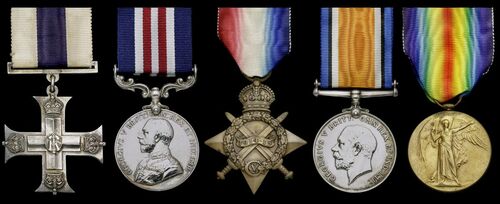Auction: 23001 - Orders, Decorations and Medals
Lot: 394
'The Squadron lost one of its best pilots on the 24th, when Capt. Burge failed to return from a patrol. He scored ten victories and was an outstanding Flight Commander. The 24th July would long remain in the memories of the members of No. 64 Squadron as Capt. Burge was one of the original members of the Squadron when it arrived in France, and was a very gallant pilot.'
A Brief History of No. 64 Squadron R.F.C./R.A.F. 1917/1917, refers
The '1918 Air Ace's' M.C., 'Battle of the Somme' M.M. group of give awarded to Captain P. S. Burge, No. 64 Squadron, Royal Air Force, late 10th (Stockbroker's) Battalion, Royal Fusiliers, who was tragically killed in action on 24 July 1918
Military Cross, G.V.R., the reverse engraved 'Captain P. S. Burge. M.M. 64 Squadron. R.A.F. 1917-18'; Military Medal, G.V.R. (Stk-1182 Pte P. Burge. 10/R. Fus.); 1914-15 Star, neatly erased; British War and Victory Medals (Capt. P. B. Burge. R.A.F.), good very fine (5)
M.C. London Gazette 16 September 1918, the original citation states:
'For conspicuous gallantry and devotion to duty. This officer is a brilliant fighting pilot, and has destroyed six enemy aeroplanes. His dash and determination when engaged in combat with the enemy, often numerically superior, have set a fine example to the remainder of his formation.'
M.M. London Gazette 1 September 1916.
Philip Scott Burge was born on 29 March 1895 at Potters Bar, Hertfordshire, the son of William and Grace Burge of 82 Holbein House, Sloane Square, London. He joined the 10th (Stockbroker’s) Battalion, Royal Fusiliers with his brother Leonard (see Lot 112) and served in France from 31 July 1915. This unit went into action in the second week of the Battle of the Somme in the La Boisselle sector. The next week they were involved in attacks on Pozieres from the direction of the La Boisselle-Contalmaison road - it was around this time that Burge won his M.M., likely for these early actions.
Continuing to serve in the ranks for the rest of 1916, Burge was commissioned 2nd Lieutenant with the Royal Flying Corps on 27 February 1917. Posted to No. 64 Squadron they began to see heavy action in November 1917 during the Battle of Cambrai with Burge noted attack ground targets in support of infantry. His first kill was a Fokker Triplane on 23 March 1918 in the company of fellow 64 Squadron ace Captain J. A. Slater; his companion had already made a kill on that patrol when the pair ambushed two Pfalz Scouts. The Fokker got the jump of the British airmen but Burge avoided the initial volley and swung onto his opponents tail firing a 50 round burst that brought his enemy down.
His next kill was shared with Slater, as Jimmy Slater Fighter Ace outlines:
'Slater and Lieutenant P S Burge ended the March scoring when between them they destroyed a German two-seater shortly before mid-day near Croiselles.'
However he was back to flying at the start of the next month on 1 April, shooting down an Albatross scout during a squadron engagement over Mametz Wood. Promoted Captain on 20 April 1918 he took over Lieutenant Walter Campbell Daniel's Flight:
'Captain McClintock was promoted and transferred as C.O. to No. 3 Squadron, and, April 20th, my birthday, the Flight was taken over by Capt. P. S. Burge, who chose me as his second in command. I was very much encouraged by his personality and leadership. This was as well, as in May we were entering the most crucial month of aerial warfare.'
(Recollections of a World War One flyer Royal Flying Corps - Royal Air Force 191701918, by Walter Campbell Daniel, refers.)
The month was indeed to prove crucial with Burge kicking off by sharing a Rumpler two-seater with Lieutenants Daniel and Walkerdine on 2 May. Confirmed Captain on 16 May, a day which proved to be the most successful No. 64 Squadron would have in the war. Burge led the central formation into the attack and more than played his part, hammering a 100-round burst into an Albatros, tearing its right hand wing off before forcing another down out of control.
This was also Burge's most successful day, however he was far from done starting with a two seater Haldberstadt on 20 May. He took consecutive kills, flying a patrol the next day to get another Haldberstadt over Laventie. Burge was awarded his M.C. in June but did not get any further kills until the next month when on 19 July he took down a Fokker Biplane south of Lille. His final two kills occurred in quick succession with one the next day on 20 July - a Rumpler - over Drocourt - and on 22 July, an Albatross D.V. north of Hernes.
Tragically he was killed only two days later when his kite, marked SE5a, was shot down. A German pilot named Marat Schumm claimed a kill that day which he identified as 'SE5' - he was an Unteroffizier with Jagdstaffel 52. Burge is generally credited with 10 kills of which three were shared, although he might be entitled to another 'forced down'. He is buried at Dud Corner Cemetery, Loos; sold together with correspondence with the Air Ministry relating to the recipients career and a silver nameplate named 'Capt. Philip S. Burge. M.C., M.M. 64 Squadron R.A.F.', hallmarked for Birmingham 1933 as well as copied research comprising Combat Reports, London Gazette entries and a Commonwealth War Graves certificate as well as extracts from, Recollections of a World War One Flyer by Walter Campbell Daniel, A Brief History of No. 64 Squadron R.F.C./R.A.F. and Jimmy Slater Fighter Ace along with service records, recommendations for award and photographs.
For the medals of the recipient's brother, who was killed in action in 1916, please see Lot 112.
Subject to 20% VAT on Buyer’s Premium. For more information please view Terms and Conditions for Buyers.
Sold for
£3,500
Starting price
£2800







